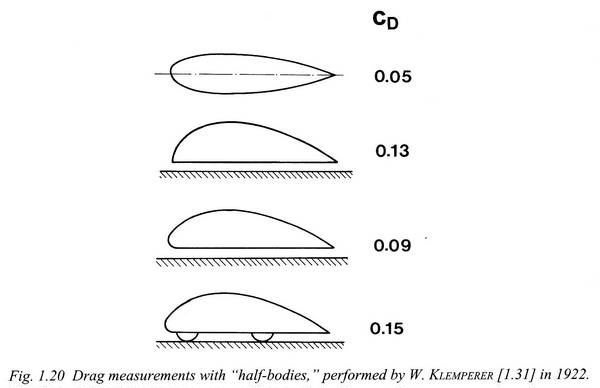
Recently I bolted a kamei front spoiler to my beetle. I was impressed with the results, which got me interested in aerodynamics. Then I stumbled on this article from the excellent website autospeed: Flowing the Porsche 993 twin turbo 4WD and the New Beetle. That article got me thinking.
Especially these parts and picture caught my eye:
“So the problem must be at the back? And it is. But it’s a different problem to that which we’ve seen before. Here the flow remains attached right down to the line of the guard/boot opening. And this results in a very small wake for the (it’s larger than you’d think) size of the car. But it also means that the airflow wraps in one long curve from the base of the windscreen right around over the top of the car to nearly the rear bumper. Aeroplane wing, did you say? And not only will this shape have major lift (without an undercar ground-effects tunnel, anyway; and I looked under and didn’t see that), but much of the force will be upwards and rearwards – creating that monster drag“
and:
“In fact, after the wool tuft session on the Beetle had finished, we gathered around the car commenting on what we’d seen. In that discussion we suggested that a spoiler – which could be used to break up that attached rear window flow and create a clean separation point – would be best placed at the top of the rear glass. It might even reduce overall drag – despite the much larger wake that would then result.”
The picture explains it all:

So, at first glance, you would think the beetle has a nice aerodynamic shape. But that is not true. The rear of the beetle drops down to fast, the angle is wrong.
The best aerodynamic shape is a raindrop shape, but that’s not a suitable shape for a car. So you’ll have to cut it in half, creating a teardrop shape:

Now, let’s see how much the beetle looks like a teardrop:
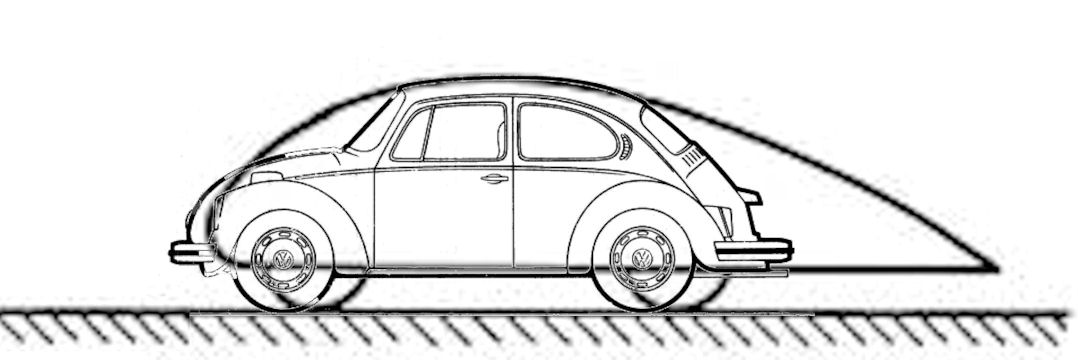
This shows that the rear of the beetle is to steep. This next picture of a windtunnel test performed by Volkswagen proves it:
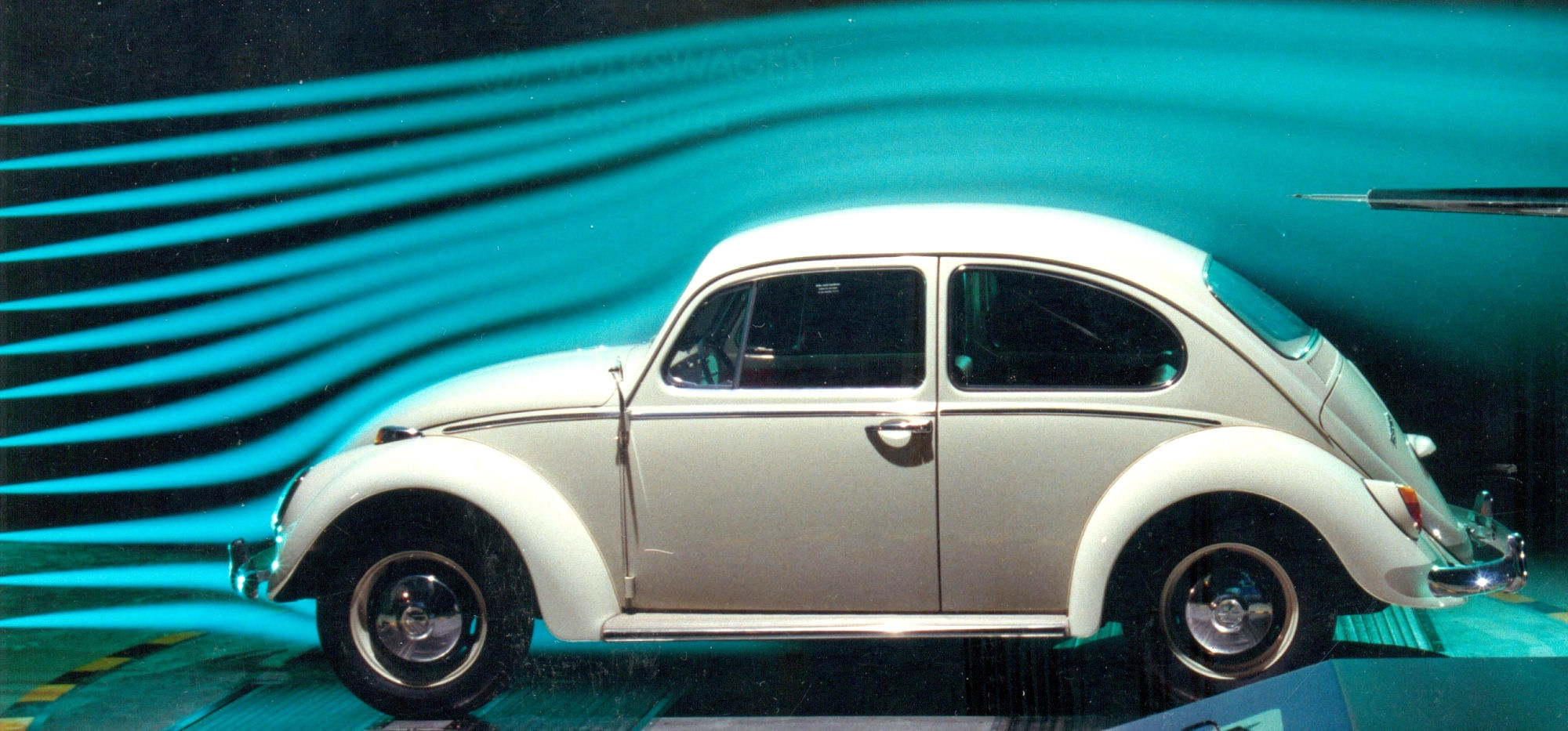
If you would want to modify the shape of the VW beetle to create a better aerodynamic shape, you would have to extend the rear a lot! It would make the car very impractical.
Luckily, it is possible to get the same effect with placing a spoiler in the right place. It’s called the Kamm effect, after a German engineer. Read this wikipedia article: Kammback
By placing a spoiler in the right place the airflow is detached from the car, the airflow breaks free. Then the airflow can flow in a nice teardrop shape.This method is used a lot on modern cars. See these excellent pictures of a Mercedes in a windtunnel:
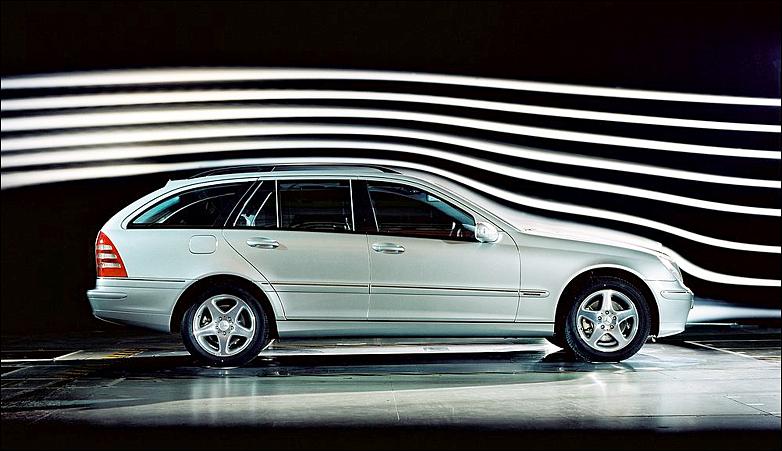
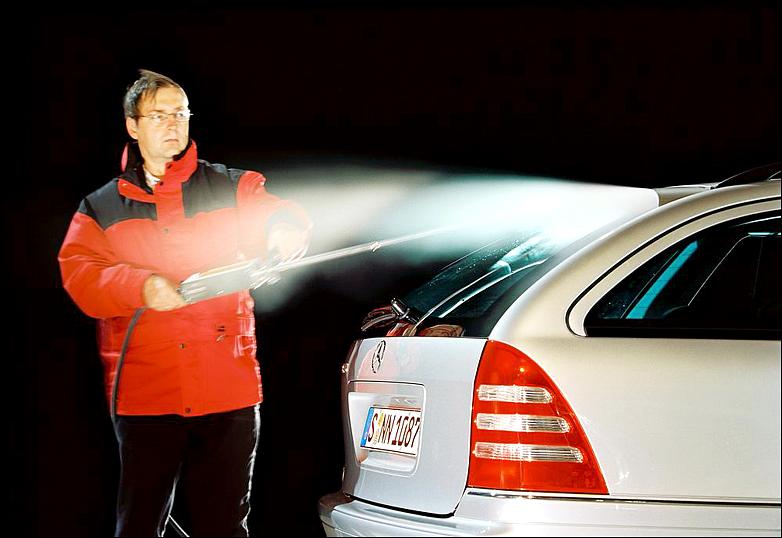
On the left picture you can nicely see the airflow is detached from the car. On the right the wake that is created behind it is demonstrated. A lot of modern cars have a little spoiler like this mercedes on the back. If you look around you will notice that especially small light cars have a roof spoiler.This is because aerodynamics have more effect on light cars then heavy cars. The heavy cars have no problem bashing through the wind resistance, that’s the reason that trucks mostly aren’t very aerodynamically shaped.
The rear of this mercedes is also sloped similar to a beetle, and a beetle is pretty light. I think the beetle would benefit from a rear spoiler too.
I’ve found this picture of a Holzapfel race beetle with a rear spoiler:
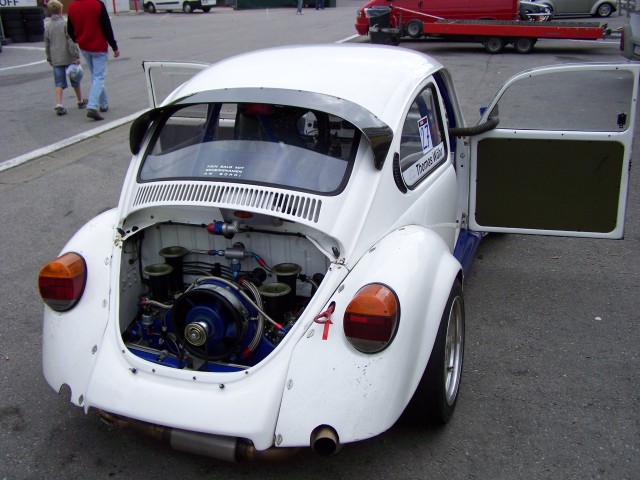
This is a little too extreme for a road-beetle, I think. It’s quite a large spoiler, but that’s probably because this car spends a lot of time at very high speeds. For a normal road car, the spoiler could be smaller.
I’ve decided to create my own roofspoiler, see: Creating a roof spoiler.

I was just wondering what this did to air supply to the engine compartment? Any idea?
Hi William,
The beetle in stock form has no air flow into the engine compartment. The engine relies on the fan to suck the air in.
The rear of the beetle (without a spoiler) has a turbulent air area at the rear decklid and above it.
See this picture:
http://images.gerrelt.nl/roofspoiler/beetle_windtunnel_test.jpg
And apparently the fan can suck enough air in from this area to cool the engine.
My spoiler doesn’t change much about this. It enlarges the turbulent air area a bit, making it start at the top of the rear window, instead of the bottom of the rear window.
I don’t think it matters much for engine cooling.
My car is now watercooled, and it get it’s cooling from the radiator in the front of the car, so maybe my car is not a good reference point. But I haven´t got any messages about this from people driving with my spoiler with aircooled engines.
Greetings,
Gerrelt.
According this the comments under “Whale Tales Part 2” it actually generated a significantly lower cylinder head temperature. Opened up a fascinating read and think about what oil temperature/cooling in a beetle is dominated by in the different modes of driving, ie. around town in urban and out on high ways at high way speed. I recently added oil temp and pressure to my recently re-built ’68 1500 to 1640 single port with old style in shroud oil cooler and have been pretty surprised at how spirited driving around town barely gets the oil above 80C but head to a high way even at 80kph it’ll head up to near 90C and then at 100kph continuous for a 10-20mins the oil temp will get to > 102C in a fairly slow creep over same time (10-20mins). In my other watercooled cars (like an Audi RS4) the oil temp will head promptly north of 100C in minutes with heavy right foot in spirited driving around urban areas while at normal high way speeds it will sit in the 90’s C.
Seems in stock beetles as you head to high way speeds the shape of the vehicle creates quite a negative air pressure on the back side of the beetle where the intake slots are for the engine bay. A decreased air pressure at the intake vents reduces the air mass the fan will pull in for a given RPM, less air mass, less cooling, higher running temperature for RPM and fuel burn rate. Putting on a whale tale, flips the pressure at the intake slots for the engine bay in to positive pressure and you see the opposite effect (ie. cooling running vs vehicle speed).
See section “Whale Tales Part 2”
http://www.clubvw.org.au/oldart012
This is what was empirically observed with air cooled engine running temperature for same ambient temperature at the same speed on a given run with and then without a whale tale. ie. add a whale tale (understanding we’re not doing this exactly with the rear window wing in this great article).
edit Gerrelt: I combined your two comments into this one.
Interesting observations of the oil temp at “spirited driving” comparing aircooled to watercooled!
It might be explained by the beetle having a fan running all the time, cooling the oil cooler, versus an oil cooler (if equiped?) with (or even without) a electric fan only switched on when getting hot.
When the watercooled car is not equiped with an oil cooler, it would explain it even more. The watercooled car will ben dependend of airflow caused by the moving car to cool the engine.
When doing “spirited driving” I imagine lots of accelerating from low speeds to higher speeds. In the low-speed part of it, the watercooled car will not receive much airflow while the aircooled car is constantly pushing air through the oil cooler.
In the aircooled car the airflow is dependent of engine RPM, in the watercooled car is dependent of it’s speed.
BTW, interesting read, the whale tales story. I like part 3 too, nice solution for getting extra air into the engine bay.
I once read an article where somebody did something similar, but he used the front engine cover plate in front of the engine (the one where also the oil cooler scoop goes through on the left side). He cut a hole into it (on the right side), and attached a an hose to it which scooped air from under the car.
Same solution, but a different way of doing it.
Hi, And this spoiler on the rear window, does it make a difference to the higher speed stability?
Hi William,
In theory: yes, this should provide greate stability. But I don’t know with what percentage.
I’ve driven 100 mph (160 km/h) in my beetle, and it felt pretty stable. But I don’t know how it felt without the spoiler.
Furthermore, my car is equiped with a Kamei front spoiler and a thicker swaybar, which helps stability too.
Greetings,
Gerrelt.
Hi Gerrelt,
I went to an airfield here today and went here with the idea to gather info on vortex generators. You will find it on F1 cars and planes. They stir the air on the higher places on the wings to force the air to follow the surface of the wing and to separate and move away like you get at the back of the beetle creating and low pressure volume. And from this low pressure area you must try and cool and feed an engine. Fans cant suck air if there is no air. I am of the opinion that vortex generators will cause the air flowing to the back of the Beetle will follow the shape of the roof flowing down over the bonnet and supply air for cooling and breathing for the engine.
Vortex generators are little wings that stir the air in spirals this disturbing the direction of flow to follow lower pressure volumes of air or areas on wings. Study it on Google .Vortex generators and design dimensions . I am going to fit a golf engine to mine . Your opinion please
Good luck.
Hi William,
A few years ago I did have a look/study into vortex generators. I found these autospeed.com articles very informative:
Autospeed.com article, Blowing the Vortex, Part 1
Autospeed.com article, Blowing the Vortex, Part 2
Autospeed.com article, Blowing the Vortex, Part 3
Autospeed.com article, Blowing the Vortex, Part 4
I didn’t entirely re-read it again, but if I remember correctly it indeed caused the air to be attached longer. Aerodynamically this might a bad thing for a beetle, because the angle of the rear of a beetle is too steep.
I think it will indeed make it easier for the engine fan to get more air, which might improve cooling.
But, if the goal is getting more cooling air to the engine, I think an under car scoop, going through the front engine firewall tin, will be a better solution.
A bit like this guy did to a bus:
thesamba.com, under car scoop through engine firewall tin
On the golf engine: why not, they seem to be good engines. But be aware that your rear decklid will not fit anymore without modifications.
Greetings,
Gerrelt.
Hi Gerrelt.
Thanx for the friendly dicussions. Keep it up and enjoy.
William
Hi there, I was reading through this about beetle Aerodynamics as it seems to have been a Hot top for years and I was looking at designs of spoilers for the purpose of stability if anything. With most of the wind tunnel tests I have seen the vehicle isnt running and part of me feels that it becomes a null test if you have an aircooled car. Having owned a beetle for many years and driven it alot in the rain, you get to see a similar effect to aerodynamic testing as the water sprays off the car, which in my experience was 2 perfect spirals off the back! I have seen that there is the area of lower pressure at the bottom of the rear window, where the engine draws its air from, it then moves this to the underside of the car exiting under the rear valance, which makes me think that playing with the aerodynamics without some better testing may not help cooling and may worsen the actual aero effect. I equally have been looking at fitting a watercooled (polo TDI) engine in my 1302s and something needed to be considered about air flow here is to actually direct some at the engine for the intercooler. I have found that having a porsche whale tail does little for the beetle, but I did find adding a rear window louver actually caused the engine to run hotter. Essentially the top of the louver acting like a small spoiler above the window. Would be interested to see how the aerodynamics are affected by the engine actually running at 3000rpm though to simulate 70mph.
Hi Dale,
For what I have read, it is indeed better to have a running car, but also the road underneath the car should be moving.
However, I don’t think the aircooled engine’s fan moves enough air to really make a difference aerodynamic wise. The low pressure area at the bottom of the rear window is caused by airflow seperation.
That’s also the reason that a spoiler shouldn’t affect cooling (i’ve never had people with my spoiler complain about less cooling with my spoiler).
A standard beetle does not have airflow into the engine room. The fan is taking it’s own air, and is not dependent on airflow.
On the Porsche whale tail: I’ve had people tell me it did improve stability. Which theoretically could be true, by creating an extension after the beetle (it almost makes it into a 3 box car design) the airflow is forced to follow a more shallow angle. The shallower angle will create less drag and less lift.
I’ve looked at the 3 cilinder VW TDI engine as a candidate for an engine swap. It would fit quite nice because it’s shorter then the 4 cilinders. But Dutch legislation and engine cost prevented me from doing it 🙁 . That was quite a few years ago, the engines will be quite a bit cheaper, but the Dutch legislation hasn’t chagned sadly.
Greetings,
Gerrelt.
Hi Gerrelt.
Have you tried modified running boards lowering the outside edge preventing air entering from the sides? Your opinion and experience on this aspect please.
William
Hi William,
No.
But I have thought of installing “wheel spats”. And I don’t mean those things that cover half of the wheel on the side (also called side skirts), but the little spoilers just in front of the wheel. These are seen ofte on the newer cars. These little spoilers prevent air from rushing up into the wheel well.
Greetings,
Gerrelt.
There is some question about the impact such a spoiler would have on engine cooling for a stock aircooled engine. Contrary to what Gerrelt has said, I’ve found it actually is problematic. I built a Holzapfel-style spoiler based on Gerrelt’s instructions on another page, making it’s length part way between that of the regular Holzapfel and Gerrelt’s small fiberglass one, if I remember right it was about 20cm long, and made of plastic, possibly ABS (this was a few years ago). Fortunately, at my Mom’s suggestion, I didn’t screw it down, held it on with Gorilla tape initially. I drove with it on the freeway at about 75mph (120 km/hr), didn’t really notice much difference in handling or power need, but the oil started getting really hot, monitoring oil. It got so bad I had to pull over and rip the spoiler off. For completeness of this data, I should include that this was at higher altitude, around 5,000 feet (1500 m), so there is less air – drag and stability improvements less significant, and the engine already struggling to get enough cooling air. I’m still thinking of trying to find a way of improving drag, possibly new air scoops on the front edges of the rear fenders (would look sort of like fighter jet air intakes) so that a spoiler won’t cook the engine. Or possibly the more common “Herrod Helper” type spoiler below the back window, possibly combined with vortex generators above the back window, with a gap between spoiler and body to allow cooling air to get into the louvers. Would like to mess with Computational Fluid Dynamics (if this engineering school ever gets around to teaching me something useful that is…) to see what design has the most benefits, and how much, how much work and expense it’s worth.
Hi Quill,
I haven’t had any of the people that use my spoiler reporting me that they had cooling issues. There are even race-beetles using them, and they get abused quite a bit.
The air doesn’t flow into the rear vents, the engine fan is sucking air in. If you look at the windtunnel picture from Volkswagen, you can see that the airflow doesn’t reach the vents without the spoiler either:
http://images.gerrelt.nl/roofspoiler/beetle_windtunnel_test.jpg
Maybe it was the high altitude in combination with the spoiler which made it harder for the engine fan to draw air in.
I once saw some pictures of somebody who had made a hole in the front engine plate (the one that closes the gap between the engine and the firewall), and connected an air duct to it on the underside of the car. The end of the duct was somewhere close to the torsion bar, scooping up cold air from under the car. He said that it improved cooling quite a lot. Which make sense. Getting air from the low pressure area behind the rear decklid is harder then getting air from the high (but messy) pressure area under the car.
edit: re-found the page: https://www.thesamba.com/vw/forum/viewtopic.php?t=361406
Greetings,
Gerrelt.
On a road trip, in my (new to me) 2004 TDI Beetle, with the rear “wale fin”, I found my car handles very well (smooth as silk) at under 100 mph. Then I noticed I had 4 snow tired and the heat was eating them alive. I ordered new rims and “Z” Toyo radials. I have been on another road trip and found that at over 110 mph the car became squirrely. I wanted to go faster but thought I should get some educated opinions.
Hi Todd,
How big is this “wale fin” and where is it located?
Greetings,
Gerrelt.
Attached flow is wonderful if you want to create lift. The question you want to ask is do you want lift at the rear of the car at speed? You must also consider the forces in relation to the body in 3D – which is not what the autospeed articles do. Now if you want to drive along at 60kph – no problem, attached flow is good. The lift forces will be so low as to be inconsequential. Hit 110kph and up and it issue is much more problematic. Also remember that the speeds are air speeds and NOT road speeds, so drive at 110kph into a 50kph head wind and the airspeed is now 160kph and the forces are not linear.
Indeed, attached flow will create lift, but I think it’s the drag that’s the main player.